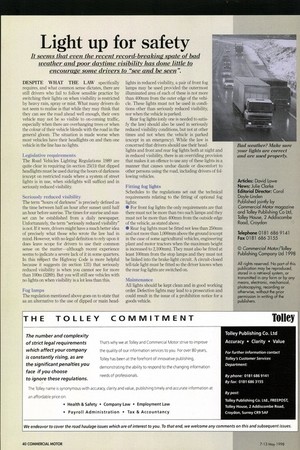Light up for safety It seems that even the recent
Page 40

If you've noticed an error in this article please click here to report it so we can fix it.
record-breaking spate of bad weather and poor daytime visibility has done little to encourage some drivers to "see and be seen".
DESPITE WHAT THE LAW specifically requires, and what common sense dictates, there are still drivers who fail to follow sensible practice by switching their lights on when visibility is restricted by heavy rain, spray or mist. What many drivers do not seem to realise is that while they may think that they can see the road ahead well enough, their own vehicle may not be so visible to on-coming traffic, especially when there are overhanging trees or when the colour of their vehicle blends with the road in the general gloom. The situation is made worse when most vehicles have their headlights on and then one vehicle in the line has no lights.
Legislative requirements The Road Vehicles Lighting Regulations 1989 are quite clear in requiring (in section 25(1)) that dipped headlights must be used during the hours of darkness (except on restricted roads where a system of street lights is in use, when sidelights will suffice) and in seriously reduced visibility Seriously reduced visibility The term "hours of darkness" is precisely defined as the time between half an hour after sunset until half an hour before sunrise. The times for sunrise and sunset can be established from a daily newspaper. Unfortunately, the term "seriously reduced visibility" is not. If it were, drivers might have a much better idea of precisely what those who wrote the law had in mind. However, with no legal definition to rely upon it does leave scope for drivers to use their common sense on the matter—although recent experience seems to indicate a severe lack of it in some quarters. In this respect the Highway Code is more helpful because it suggests (in section 131) that seriously reduced visibility is when you cannot see for more than 100m (328ft). But you will still see vehicles with no lights on when visibility is a lot less than this.
Fog lamps The regulation mentioned above goes on to state that as an alternative to the use of dipped or main head lights in reduced visibility, a pair of front fog lamps may be used provided the outermost illuminated area of each of these is not more than 400mm from the outer edge of the vehicle. These lights must not be used in conditions other than seriously reduced visibility, nor when the vehicle is parked.
Rear fog lights (only one is needed to satisfy the law) should also be used in seriously reduced visibility conditions, but not at other times and not when the vehicle is parked (except in an emergency). While the law is concerned that drivers should use their headlights and front and rear fog lights both at night and in reduced visibility, there is an overriding provision that makes it an offence to use any of these lights in a manner that causes undue dazzle or discomfort to other persons using the road, including drivers of following vehicles.
Fitting fog lights Schedules to the regulations set out the technical requirements relating to the fitting of optional fog lights: • For front fog lights the only requirements are that there must not be more than two such lamps and they must not be more than 400mm from the outside edge of the vehicle, as stated above.
• Rear fog lights must be fitted not less than 250mm and not more than 1,000mm above the ground (except in the case of some agricultural vehicles, engineering plant and motor tractors when the maximum height is increased to 2,100mm). They must also be fitted at least 100mm from the stop lamps and they must not be linked into the brake-light circuit. A circuit-closed tell-tale light must be fitted so the driver knows when the rear fog lights are switched on.
Maintenance All lights should be kept clean and in good working order. Defective lights may lead to a prosecution and could result in the issue of a prohibition notice for a goods vehicle.
























































































































